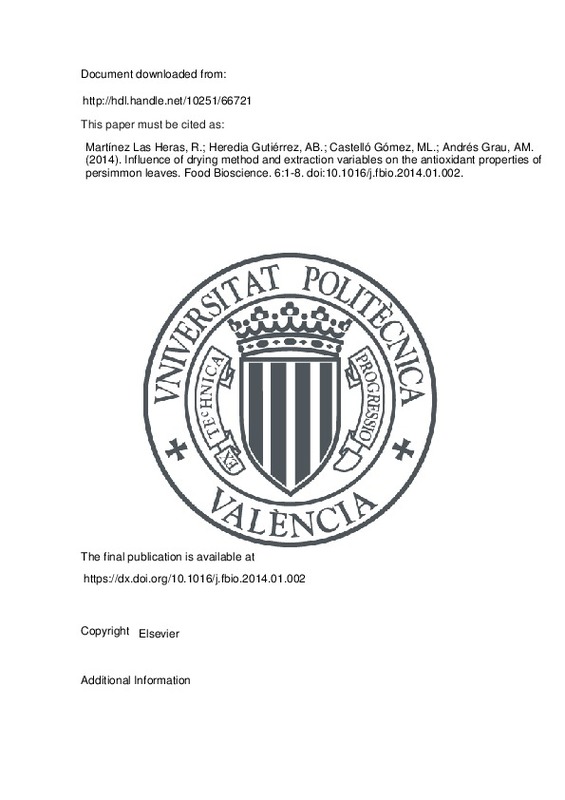JavaScript is disabled for your browser. Some features of this site may not work without it.
Buscar en RiuNet
Listar
Mi cuenta
Estadísticas
Ayuda RiuNet
Admin. UPV
Influence of drying method and extraction variables on the antioxidant properties of persimmon leaves
Mostrar el registro sencillo del ítem
Ficheros en el ítem
| dc.contributor.author | Martínez las Heras, Ruth
|
es_ES |
| dc.contributor.author | Heredia Gutiérrez, Ana Belén
|
es_ES |
| dc.contributor.author | Castelló Gómez, María Luisa
|
es_ES |
| dc.contributor.author | Andrés Grau, Ana María
|
es_ES |
| dc.date.accessioned | 2016-06-29T06:35:00Z | |
| dc.date.available | 2016-06-29T06:35:00Z | |
| dc.date.issued | 2014 | |
| dc.identifier.issn | 2212-4292 | |
| dc.identifier.uri | http://hdl.handle.net/10251/66721 | |
| dc.description.abstract | [EN] The presence of antioxidant compounds and therefore the antioxidant capacity of persimmon leaves and their extracts have been reported by many authors. Furthermore, it is known that both the method of drying and the temperature at which this process takes place substantially affect the properties of the final product. However, there are no studies in the literature that examine how drying variables can affect the quality of persimmon leaves, especially as refers to preservation of their antioxidant properties. Therefore, the aim of this paper was to compare some antioxidant properties of aqueous extracts of persimmon leaves obtained under different drying methods (shade drying, hot air drying at 100 and 180 °C, and freeze drying) and infusion conditions (70, 80 and 90 °C for 1, 3, 5, 60 and 1440 min). The results in terms of total phenol content, flavonoids and antioxidant capacity indicated that air drying at 100 °C would be the optimal process for the stabilization of persimmon leaves, and their subsequent use in brewed beverages. Likewise, the best conditions of aqueous extraction in order to maximize the extractability of antioxidant compounds corresponded to 90 °C for 60 min. A short experiment performed in this study confirmed that small persimmon leaves (axial axis: 9±1 (cm); equatorial axis: 7.0±0.9 (cm)) had around 9% more flavonoids, and 7% more total phenolic content and antioxidant capacity than the large ones (axial axis: 17±2 (cm); equatorial axis: 10±1 (cm)). | es_ES |
| dc.description.sponsorship | The authors acknowledge the support of the Universtitat Politecnica de Valencia and certify that there is no conflict of interest with any financial organization regarding the material discussed in the manuscript. | en_EN |
| dc.language | Inglés | es_ES |
| dc.publisher | Elsevier | es_ES |
| dc.relation.ispartof | Food Bioscience | es_ES |
| dc.rights | Reserva de todos los derechos | es_ES |
| dc.subject | Persimmon leaves | es_ES |
| dc.subject | Drying method | es_ES |
| dc.subject | Antioxidant properties | es_ES |
| dc.subject | Leaf size | es_ES |
| dc.subject.classification | TECNOLOGIA DE ALIMENTOS | es_ES |
| dc.title | Influence of drying method and extraction variables on the antioxidant properties of persimmon leaves | es_ES |
| dc.type | Artículo | es_ES |
| dc.identifier.doi | 10.1016/j.fbio.2014.01.002 | |
| dc.rights.accessRights | Abierto | es_ES |
| dc.contributor.affiliation | Universitat Politècnica de València. Departamento de Tecnología de Alimentos - Departament de Tecnologia d'Aliments | es_ES |
| dc.contributor.affiliation | Universitat Politècnica de València. Instituto Universitario de Ingeniería de Alimentos para el Desarrollo - Institut Universitari d'Enginyeria d'Aliments per al Desenvolupament | es_ES |
| dc.description.bibliographicCitation | Martínez Las Heras, R.; Heredia Gutiérrez, AB.; Castelló Gómez, ML.; Andrés Grau, AM. (2014). Influence of drying method and extraction variables on the antioxidant properties of persimmon leaves. Food Bioscience. 6:1-8. doi:10.1016/j.fbio.2014.01.002 | es_ES |
| dc.description.accrualMethod | S | es_ES |
| dc.relation.publisherversion | https://dx.doi.org/10.1016/j.fbio.2014.01.002 | es_ES |
| dc.description.upvformatpinicio | 1 | es_ES |
| dc.description.upvformatpfin | 8 | es_ES |
| dc.type.version | info:eu-repo/semantics/publishedVersion | es_ES |
| dc.description.volume | 6 | es_ES |
| dc.relation.senia | 258540 | es_ES |
| dc.identifier.eissn | 2212-4306 | |
| dc.contributor.funder | Universitat Politècnica de València | es_ES |







![[Cerrado]](/themes/UPV/images/candado.png)

